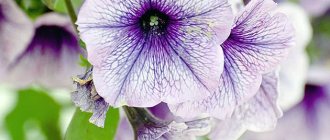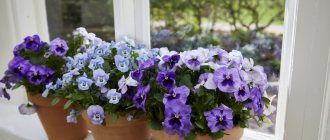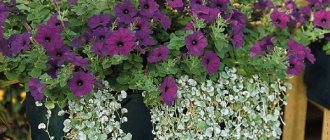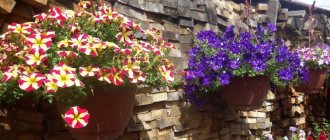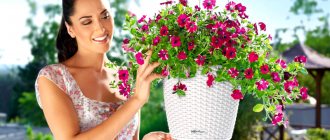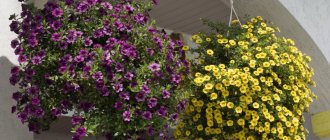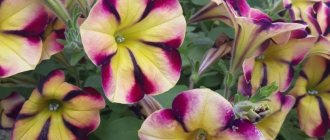What not to grow on the balcony, if it is properly landscaped! These are herbs, indoor flowers, vegetables and even some fruits. However, if you prefer to admire not the greenery, but the riot of colors, then there is no better option than petunias on the balcony. The variety of varieties, original colors, and ease of care for them have captivated more than one person. But in order for boxes or hanging flowerpots to be practically hidden under the flower carpet, you need to know some secrets of choosing and growing petunias.
Features of the root system of petunias
Before growing petunia in a pot, you need to study its features. An incorrect calculation when choosing a container will damage the roots of the plant and lead to its death.
Variety of petunias on the balcony
The culture has a fibrous rhizome consisting of many whitish roots. They quickly grow throughout the container, but this does not prevent the plant from being planted in flowerpots and flowerpots.
Transplanting and planting work does not cause difficulties. The process takes place in a few minutes; it is better to transfer the seedlings along with the soil in which they grew.
Petunia in pots takes root well on a loggia or in a room. It is used for room decoration.
Flower root system
What kind of soil is needed for petunias?
Petunias that are grown in boxes and flower pots require a special soil composition. It should be loose, moisture-permeable, light. In this regard, a purchased universal peat-based soil is well suited. As additives, it is recommended to dilute it with leavening agents (perlite or vermiculite), a small amount of sand and vermicompost. Some gardeners grow petunias in the following soil: garden soil is mixed with peat soil and baking powder in a ratio of 3:3:0.5. The soil for petunias should not consist only of garden soil - it is too heavy, cracks between waterings and does not allow the roots to “breathe”.
Varieties for home cultivation
For planting in closed conditions, two types of crops are used:
- ampelous - its stems grow up to 1.2 m, hanging down, and can break off during strong gusts of wind;
- cascading - characterized by dense shoots, 1.5 m long, initially they grow upward, and then begin to smoothly fall down.
How is surfinia different from petunia - care and cultivation
The best varietal types of balcony petunia are presented:
- Velveteen - has velvety and small flowers;
- Gioconda - with purple-lavender inflorescences;
- Ekaterina - painted in salmon tones;
- Mashenka - with pink buds;
- Opera suprim - belonging to the small-flowered subspecies;
- Snow Queen - stands out with snow-white petals;
- Typhoon - with long and abundant flowering;
- Black velvet - with burgundy-black petals.
Important! All of these representatives have long, hanging shoots. The bushes are strewn with flowers with a pleasant aroma.
Petunia Ramblin'
Varieties and varieties of balcony petunia
Petunia for growing on the balcony is represented by three types:
- bush
- ampel;
- cascading.
Balcony petunia is cultivated in several varieties:
- Miniature - reaches a maximum height of 25 centimeters. Has many small flowers. Unpretentious, easily tolerates both high humidity and heat.
Miniature
- Large-flowered - reaches a height of 50 centimeters. Flowers in diameter are up to 12 centimeters, double and ordinary. Conventional plants propagate by seeds and cuttings. Terry - only by cuttings.
Large-flowered
- Ampelous is a climbing plant with long thin stems and large flowers. Hanging down, petunia forms beautiful, bright garlands.
Ampelnaya
- Ampelous miniature is the most capricious type of petunia. Thin and fragile stems break from wind and rain. Not suitable for open balconies. Propagated only by cuttings.
- Cascading - at the beginning of growth, the flower stretches upward; Having reached the required point, it diverges to the sides, going down in a cascade. Medium size flowers. Propagated by cuttings and seeds.
Cascade
- Multi-flowered - this is a low plant, reaching a height of up to 30 centimeters, pleasing to the eye with a huge number of small flowers. It tolerates any bad weather well. It reproduces in two ways.
Multiflora
Ampelous and cascading plants require special care and a special location.
What are the different types of pots?
How dracaena blooms - what types, proper care
Why does petunia grow poorly in pots: before planting, you need to select the right container. The florist can choose the most suitable product or create it himself.
- Kapsho
Refers to decorative containers in which pots with plants are placed. You can initially buy larger containers with an eye toward the future.
Flower in a flowerpot
- Vases
They are made of gypsum, metal, ceramic, clay, concrete or stone material. Designed for outdoor use and balconies.
- Pots
They can be made from clay, ceramics, plastic and other materials.
- Designer pots
When choosing, take into account appearance and functionality. When purchasing, pay attention to the presence of drainage, air permeability and the shape of the vessel.
Important! The best option is to buy an original flowerpot. The pot will have to be changed annually and its appearance will not play any role.
Size
The volume of the container depends on the growth rate. Gardeners prefer to choose larger containers so that the roots have enough space.
Material
It is better to take breathable options: clay, ceramic or wooden. Metal and other types can be used, but they must have drainage holes.
Important! It is better to choose light colored pots. Dark items will heat up and keep warm.
Pot options
Specialized (other types)
Non-standard containers include:
- made of silicone - the curved edges of the dish are bent as the flower grows, thereby increasing its volume;
- hanging pot and flowerpot - as an alternative to a regular flowerpot, allowing you to lift plants up;
- with lighting - flowerpots are used for room design;
- florarium - made of transparent glass, used for light-loving varieties.
Important! Containers with an automatic watering system are suitable for crops that require regular moisture.
Neon illuminated
What types of petunias are grown in pots?
Various varieties of the described herbaceous plant can be grown at home on the window in pots, as well as in cocovits and flowerpots.
Petunia is a hybrid crop represented by several varieties.
Below you can see the table indicating which types of plants are allowed to be grown in flower pots and hanging pots.
| Group name | Characteristics and description of species |
| Ampelnaya | The branches grow exclusively downwards. In this regard, it is advisable to grow such petunia in flower pots. Varieties of the ampelous variety: “supertunia”, “tumbelina”, “conchita”, “surfinia”. |
| Cascade | Shoots are formed that stretch in different directions, creating thickets of flowers. Suitable for decorating terraces and gazebos. There are varieties that can grow shoots reaching 1.5 meters. Varieties: “ramblin”, “silver”, “cherry”. |
| Bush hybrid | These varieties are suitable for decorating ridges, borders and garden beds. It is permissible to grow small hybrid varieties in flowerpots and pots. Hybrids include subgroups called “microflora” and “grandiflora”. The first is characterized by the average size of the flowers, as well as a huge number of inflorescences. In the second subgroup, the size of flowers can reach 16 centimeters. Popular bush hybrid varieties of petunias: “titanium”, “ultra”, “dream” and “hit parade”. Shrubs are capable of forming independently. However, in order for the branching to be lush, it is necessary to trim the upper part of the plant. |
| Floribunda | Withstands bad weather very well. It is intermediate between “grandiflora” and “microflora”. This group may also include terry varieties of the crop. Varieties: “dormouse”, “celebrity”. |
Any type of flower crop can be planted on the site to improve the garden landscape.
Which pot is best for a particular flower?
Lemon tree - caring for a houseplant
When choosing a container, it is guided by the type of flower. Terry ones require a volume of 3 liters, regular ones - up to 5 liters.
How many petunias can be planted in one pot: the final quantity depends on the volume of the container. With a diameter of up to 30 cm, replanting 3 bushes is allowed.
Seedlings grown from seeds are small in size and are initially planted in a small temporary container. The size should exceed the volume of the roots by 3-4 cm.
Containers for seedlings
Two types of soil moisture are usually used:
- artificial - with adjustment of the volume of liquid, the container must have drainage holes;
- natural - when the flowerpot is on the street.
Important! The best option for garden plants is to plant petunias in flowerpots. Excess water accumulated from rain will drain away on its own.
Landing on the balcony
When sending plants to the loggia, it is better to use the following containers:
- made of clay;
- ceramics;
- gypsum;
- concrete;
- stainless metal.
Important! Wooden containers must be covered with a waterproof layer.
Pot diameter 20 cm: how many petunias should I plant?
You should plant no more than two shoots in a large pot. In a pot with a diameter of 20 cm, it is enough to plant just one sprout. If you think that with a large number of sprouts you will get a lush bush, then you are mistaken. The roots of the plants will interfere with each other. Therefore, the optimal quantity is one bush. With proper care it will grow well and be lush.
Pot diameter 20 cm: how many petunias should I plant?
How to make a pot with your own hands at home
The annual purchase of new vessels is easily replaced by self-made containers. Pots can be made from simple materials.
Available materials
To create the product you use:
- gypsum;
- concrete;
- tree;
- clay base.
Some craftsmen prefer to use brushwood or vines.
Important! Old buckets, jars, and plastic containers are suitable as a base.
Making containers from gypsum
List of components
Depending on the option chosen, you may additionally need:
- water - for products made of gypsum, concrete and clay;
- varnish - to protect wood from moisture;
- quick fix adhesive.
When weaving containers, strong twine, burlap and a plastic base are used.
Care during growth
To form a plant with a beautiful spherical shape, you need to properly care for it.
May
The two main components of care in May are fertilizing and bush formation.
- Formation. Remove all flowers and buds within two weeks of transplanting into permanent pots. The flower now needs to recover after transplantation and grow shoots, and flowering will take a lot of energy from it.
- Feeding. To grow green mass, the plant needs nitrogen. Until the petunia reaches the volume you need, add a nitrogen-containing fertilizer, such as urea. Root feeding is carried out either once a week (dissolve 1 tablespoon in 10 liters of water), or with each watering (1 teaspoon per 10 liters of water).
June
In June, you should change your approach to feeding petunias. If the flower has already grown the required amount of green mass, it means that it is no longer necessary to stimulate its growth, but the formation of buds and flowering. To do this, replace nitrogen fertilizers with potassium-phosphorus ones. For example, potassium monophosphate will help to activate flowering. Its dosage, as in the situation with urea, depends on the frequency of fertilizing. When feeding once a week, dissolve 1 tsp in 10 liters of water. fertilizers If you fertilize the plant during each watering, then 1/3 tsp is enough. for the same volume of water. Use potassium-phosphorus fertilizers until mid-July.
If the “green cap” on the plant is not yet large enough, continue to feed the petunia with urea in June: 1 tsp. dissolve in 10 liters of water and add fertilizer with each watering.
Continue to pay attention to the formation of the petunia. Inspect the plant regularly and remove:
- dry leaves;
- wilted inflorescences;
- dried tips of shoots;
- seed pods.
The first three points will help keep the plant looking neater and more aesthetically pleasing. But removing the seed pods will help prolong the flowering of petunia and make it more colorful and abundant. In this case, the plant will not spend its energy on setting seeds, but will spend it on flowers.
July
By mid-summer, the appearance of petunia will no longer delight you with its ideal shape as in previous months: the shoots lengthen, flowering becomes less abundant. This is a signal that it is time to cut the petunia. If you do not do this, then in August the plant will stop blooming altogether.
How to properly carry out anti-aging pruning of petunia?
- Disinfect the tool you will use for pruning.
- Trim off any shoots that hang down along the edge of the pot. To make them softer and easier to trim, do not water the plant the day before.
- Once the edges are removed, start working on the middle part of the flower. Cut off all regrown shoots from the top.
- To prevent fungal diseases, treat petunia with Chistotsvet fungicide: dilute 0.5 ml of the drug in 1 liter of water and spray the flower.
- Petunia after pruning, as at the beginning of the growing season, needs nitrogen in order to quickly grow shoots. For this reason, fertilizing with nitrogen-containing fertilizer should be resumed. Feed the flower for the first time immediately after pruning. Dilute 1 tsp. urea in 10 liters of water and water the plant. Apply this type of fertilizing every time you water. Do this until the petunia grows the required amount of green mass.
Further care - until the end of the season - consists of removing faded inflorescences, regular watering and fertilizing with potassium-phosphorus fertilizers.
Petunia is a fairly hardy plant, but it will show itself in all its glory only with your participation.
Landing rules
When planting plants, you must not forget about containers, soil and precise implementation of step-by-step instructions.
Selection of capacity
Any container is suitable for planting material. The second most important issue is the correct choice of soil for petunias.
Preparing seedlings for planting
How to properly grow ampelous petunia:
- A drainage base is poured into the bottom of the box, and soil is placed on top.
- The seed material is scattered over the surface and lightly sprinkled with soil.
- After watering, the container is covered with polyethylene and sent to the southern windowsill.
- After the sprouts appear, the film is removed.
- Picking takes place after the formation of 2-3 full-fledged leaves on each bush.
Important! It is better to plant the crop in peat pots, and then transfer the seedlings with them to a permanent place.
Transplanting several plants
Preparation or selection of soil mixture
Which soil do petunias prefer:
- with sufficient moisture capacity and level of friability;
- acidity from 5.5 to 5.7 pH - the level is measured before planting seeds;
- nominal amount of nutrients.
You can buy soil for petunia at a flower shop or make it yourself. The substrate should include:
- coconut fiber;
- agroperlite;
- universal earth;
- wood ash.
Important! When propagating, garden soil for petunias is pre-etched with boiling water and covered with polyethylene. After cooling, the process is repeated. To be safe, you can use a solution of potassium permanganate.
Ready soil
Step-by-step instructions for planting in a pot
Before work, it is determined how many flowers will be in one container. When planting several, the maximum permissible distance is maintained between them. The procedure takes place in stages:
- The bottom of the container is lined with agroperlite.
- Soil is laid on top.
- Carefully plant young trees, trying not to damage the root system.
- The cavities are filled with earth, the soil is moistened abundantly with warm water.
Important! After the young growth has grown, the tops of the longest individuals are pinched off. This approach will allow you to get compact and lush bushes. If desired, you can not form them, but let the plant produce long shoots.
Transplanting seedlings into pots
When transplanting a flower into a pot, you need to decide how many bushes to plant in one container. If you plan to plant more than 1, then it is better to leave as much distance between them as possible.
Important! Agroperlite must be poured into the bottom of the container, and then only soil. After planting the seedlings, the soil is watered generously with warm water.
After some time, when the bushes grow, they will need to be shaped. Pinch off the top of the longest stems. This will make the bushes more lush. Although you can do without formation. Long hanging stems will also look very beautiful.
What do seedlings look like?
What conditions must be observed when caring for decorative petunias?
How to care for petunia on the balcony: it is provided with optimal conditions for growth and development.
Temperature
The room temperature is constantly maintained at 18 degrees or more. The culture is known for its heat-loving nature.
Watering and humidity
The plant does not tolerate dry air well and requires regular spraying with warm water. The constant humidity level should be between 60 and 70%.
Watering is carried out as the soil dries out; in summer, it occurs daily. Moistening the soil should be done after sunset - otherwise burns will occur on the delicate foliage. The liquid is used after two days of settling.
Important! The use of ice water can become a source of fungal infections. Excessive waterlogging causes the root system to rot, and the flower will disappear.
Watering plants
Lighting
The light-loving flower needs diffused sunlight; preference is given to western and eastern windows. The north side is not suitable for it - the lack of ultraviolet rays will lead to weakening and soreness of the plant.
Important! The culture grows and develops poorly in the shade. On the south side, it quickly gets burned and can die from lack of moisture and dry air.
Feeding
In case of slow or stopped development, the causes of the abnormal state of the plant include an insufficient amount of useful substances. When growing it in containers on balconies or loggias, fertilizing should be done regularly.
In a small container, the soil quickly becomes poor, the flower begins to turn yellow and dry out. If you don't fertilize, it will quickly disappear. To improve the condition of the soil, both mineral and organic compounds are used. Experts recommend adhering to the following rules:
- regular fertilization of the soil with special mineral mixtures for flowering plants - they are sold in flower shops;
- fertilizing is applied only to pre-moistened soil;
- It is better to use liquid formulations.
Important! The first feeding is carried out after the formation of the second leaf. For lush flowering, nitrogenous substances are used, and in the second half of summer, preference is given to phosphorus and potassium elements.
Special fertilizer
All four sides of the world...
Important conditions for growing petunias are light and air. Moreover, these two components are equally important. Petunia will wither in deep shade (for example, on a balcony darkened by trees), as well as on a light but glazed loggia, where there is little fresh air flow.
Petunia loves open and sunny balconies facing south and southeast, where it will bloom especially luxuriantly. However, modern varieties of petunias (for example, supertunia, minitunia, fortunia) also perform well on the north side, being planted in balcony boxes. Therefore, if you have a northern balcony, never choose simple petunias for it, they will stretch and bloom sparingly, only expensive seeds of modern hybrids will save you. Do not spare money - luxurious flowers are worth it!
Features of care during the rest period (winter)
The culture belongs to perennials, but on Russian territory it cannot survive the harsh winter. The original homeland of petunias is Brazil, with a hot climate. In winter, the unprotected flower dies. When grown at home, it will delight its owner for many years, and will not disappear when the weather gets cold.
Features of winter crop care include:
- additional lighting - the problem is solved with the help of special lamps that allow you to increase daylight hours to 12 hours; after dark they are turned on and left until dawn;
- reduction in air dryness - central heating radiators cause it to dry out, leading to the appearance of spider mites or powdery mildew, the issue is solved by placing a glass of water near the pot or by frequent spraying.
Important! In winter, the crop needs to be watered less often. At this time, fertilizers are not applied.
Phytolamps for flowers
Shower for petunias
On dry summer days, petunias should be sprayed with warm water from a spray bottle. This will be a good preventative measure against spider mites and will saturate the plant with moisture from the outside. Evening heavy spraying has a great effect on the condition of petunias, making them healthier and stronger. Spraying should be carried out when the sun leaves your balcony. Otherwise, sunburn will certainly remain on the plants - the rays will pass through drops of water, as if through lenses, and burn through the leaf plate.
Is it possible to plant indoor petunia outside?
Transplanting a home flower under the open sky is carried out with the onset of warm weather. The main requirement is to maintain the integrity of the root system when carrying out planting work.
Seedlings take root in a new place faster; problems may arise with adults. It is better to plant them together with the soil in which they grew in a container.
Petunia can live both on a dacha plot and at home. In the latter case, this will extend the life of the beautiful plant and allow you to enjoy it at any time of the year. Fulfilling the requirements for watering, fertilizing and air humidification allows you to obtain abundant and massive flowering. And the unusual design is ready to completely change the design of the room.
Growing petunias from seeds
Growing flowers from seeds means their successful adaptation to the climate of your region and the microclimate of the glass balcony, guaranteeing that you will receive exactly the variety that you have chosen. To do this, it is necessary to purchase seeds from well-known manufacturers and recognized breeders.
When to sow petunias
You can decide on the sowing date yourself by assessing the growing conditions of the plants. If a landscaped balcony or loggia faces south and you can provide the flowers with additional lighting, then you can plant the seeds as early as mid-to-late February.
If the balcony is poorly lit, and you are not ready to spend money on fluorescent lighting lamps, then you should start sowing no earlier than the first half of March.
The correct time for planting petunias largely determines the appearance of the bush, the quality and duration of its flowering.
Preparing seeds and soil for planting
Petunia seeds are very small, so for ease of planting, manufacturers place them in special granules. Granulated seeds are easier to distribute over the soil and count them. They don't need to be soaked.
Granulated seeds in a plastic capsule
Seeds without shell
When it comes to soil, you have the following options:
- Ready-made soil mixture, neutral or slightly acidic.
- A self-made mixture of leaf soil, humus, high peat, sand in a ratio of 2:2:2:1.
- Garden soil from eggplants and tomatoes. She should stock up in advance.
The soil for seedlings should be nutritious, loose, breathable and easily absorb moisture. That is why disintegrants such as wood ash, sand or perlite must be present in the soil mixture.
Important! Before planting, the soil should be disinfected. It can be poured with a weak solution of potassium permanganate or boiling water, and calcined in the oven or microwave.
How to plant seeds correctly
Petunias are rarely sown directly into containers intended for adult plants. Usually special cassettes with cells 2-3 cm in diameter or peat tablets are used. Landing can be done in several ways.
- Simply scatter them over the surface of moistened and lightly compacted soil. Spray with a spray bottle.
- Place a layer of snow several centimeters deep in the planting container and distribute the seeds over it. When the snow melts, it will pull the seeds into the top layer of soil.
- Place the seeds on the ground, sprinkle them with sand (1-2 mm) and moisten them with a spray bottle.
If you are using peat tablets or cassettes with cells, place 1-3 seeds in each. Are you planting it in a large box right away? Then maintain a distance of 10-12 cm between the seeds.
One of the sowing methods is in the snow.
If purchased seeds are not placed in a pellet, they can be quite difficult to separate. A wooden toothpick will help make working with such planting material easier.
The planting container is covered with glass, a transparent lid or film. The soil underneath them should not dry out. As soon as the first shoots appear, the container can be opened for ventilation, gradually increasing the duration of this procedure.
Ventilation of flower seedlings
Important! Good lighting is not needed for seed germination. It is much more important to ensure appropriate temperature conditions - not lower than +25°C.
Seedling care and picking
Once the petunias germinate, the heat fades into the background. A comfortable temperature for their growth should be maintained at only +18..+20°C.
When the time comes to remove the film from the planting container, slightly grown seedlings can be gradually “hardened off”. To do this, the air temperature is reduced to +10°C. Start with 10 minutes, gradually increasing the time. Carry out the procedure for at least two weeks. Hardened petunias are stronger and more weather resistant.
Young seedlings in peat tablets
Additional lighting at this stage is necessary for 10-12 hours. For this purpose fluorescent lamps are used.
An important point is feeding flowers. The first time it can be done 10 days after the seedlings emerge. Then fertilizers are applied every 2 weeks. For flowering plants, it is preferable to use compounds with a predominance of potassium. An excess of nitrogen increases their green mass, but negatively affects the quantity and quality of buds.
Fertilizers are applied by watering the soil (root feeding) or spraying the above-ground part (foliar feeding). However, the second method is good specifically for young seedlings.
When they have the first normal leaf, you can perform a pick - transplant the plants separately into a larger container. For these purposes, transparent plastic cups with a volume of 100-200 ml are usually used. To avoid damaging the thin root, grab the seedling along with the soil. This can be done using a regular spoon.
Picking petunia seedlings
Note! If you plant petunias in 100 ml cups, you will have to replant them again. This is done after the appearance of the fifth or sixth leaf. Drinking into a 200 ml glass will save you from this procedure. From it, plants can be immediately planted for a permanent “place of residence.”
Caring for an adult plant
Caring for adult petunia involves regulating watering, forming a bush, and protecting it from negative external influences.
Watering should be carried out so that the soil is slightly moistened. Overwatering and drying out of the soil should be avoided. Petunias dislike both equally. Experienced gardeners recommend watering them in the evening, and in extreme heat - in the early morning and evening.
Advice. If peat predominates in the soil, then watering by immersing the pot in water will be useful. Practice this once a week.
Do not forget to regularly loosen the soil in the planting container. She must “breathe”.
As for pruning, any petunia can be given free rein to grow and not be shaped artificially. However, if you want to make the bush plant more branched and give the hanging plant a clear shape, you cannot do without pruning and pinching. The first pinching can be done after the fifth leaf appears, and then as needed.
First pruning of the seedling
It is important to protect petunias from wind, rain, and scorching sun. If you have a glazed balcony, then there will be no problems with this. It is enough to close the window sashes. You can shade them with tulle. If there is no glazing, you can use a trellis, install a canopy, or simply place other flowers closer to the parapet.
Plant nutrition
It is important not to forget about fertilizers. It is recommended to “feed” the petunia every 2 weeks. It is quite unpretentious to fertilizers. Any composition for flowering crops will suit her. The application of fertilizer enriched with potassium will have a particularly beneficial effect on its growth.
You can add a stimulant to the feeding. It will significantly increase the crop’s resistance to possible temperature changes. In addition, the stimulator will improve your appearance. Petunia will “shine” with even brighter and richer shades.
What diseases may appear
Growing and caring for petunias may be accompanied by the occurrence of diseases on flowers. So, due to excessive watering, fungal diseases often appear. Treatment with “Topaz” or “Fundazol” will help against powdery mildew. Yellowing of green shoots usually signals chlorosis, which is treated with iron-based preparations.
Unexplained wilting of leaves and flowers indicates the appearance of a common pest - spider mites. Treating petunias with Fitoverm or another commercially available acaricide will protect petunias from it. Disinsection is usually carried out several times.
Balcony design with petunias
The most important thing when decorating a balcony with petunias is a properly selected planting container for each variety. It is this that allows you to fully reveal the beauty of plants.
So, to decorate the parapet area, boxes attached to it and hanging flowerpots are ideal. Hanging varieties will feel comfortable in them.
Decorating a parapet on an open balcony
Cascading petunias can be planted in long boxes and flowerpots located along the end walls of the balcony.
Branched, abundantly flowering bush varieties look good in flowerpots on the floor. Very small bushes will be placed on window sills.
If you wish, you can create a “blooming corner” on the balcony. Try to use petunias at different levels - from floor to ceiling. It will look impressive. This solution is suitable for those who, in addition to flowers, have a wardrobe, sofa or other pieces of furniture on the balcony that take up space.
Properly chosen, lovingly grown petunias will certainly delight you with beautiful, long-lasting flowering. And with a competent approach to the design of the balcony, they will surprise passers-by.
